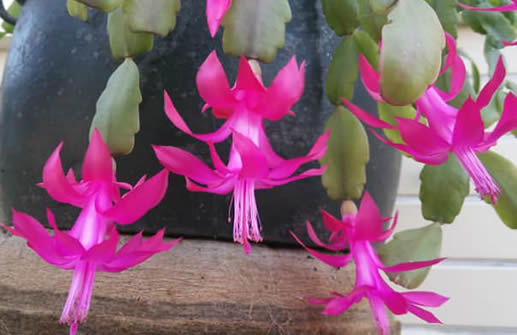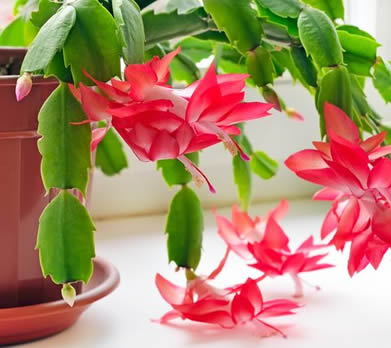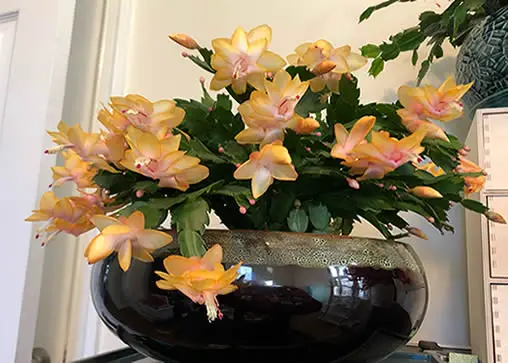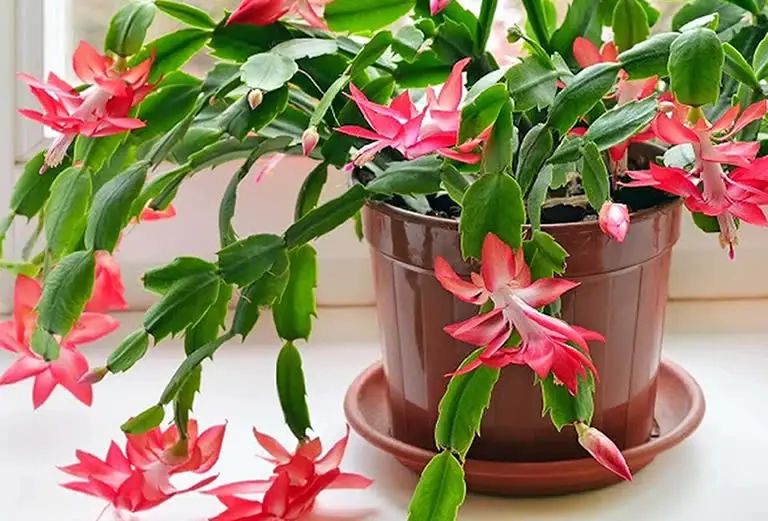There is nothing more frustrating to an indoor gardener than having a houseplant that’s been carefully looked after but it refuses to bloom. Having a christmas cactus that fails to bloom is a fairly common problem encountered by many houseplant owners.
Luckily, the solution to the problem will lie in one of six possible causes, each of which has an easy-to-implement quick-fix.
Table of Contents
- 6 Reasons Why Your Christmas Cactus Won’t Bloom
- 1. The wrong type of soil can prevent a christmas cactus from blooming
- 2. A temperature range outside the tolerances of christmas cactus means no flowers
- 3. Low humidity will make it difficult for a christmas cactus to bloom
- 4. Insufficient or incorrect light will make it impossible for a christmas cactus to flower
- 5. An inappropriate watering routine can lead to more than non-blooming prolems!
- 6. Using the wrong fertilizer & incorrect feeding can cause havoc with christmas cactus’ growth
6 Reasons Why Your Christmas Cactus Won’t Bloom
Christmas cactus is usually an easy to cultivate succulent – see our christmas cactus growing guide. This makes it a very popular houseplant all across the USA.
It is a tropical succulent plant that grows natively in shaded areas of south-east Brazil. Although it is an easy-care plant, being a tropical succulent it requires a very specific care routine in order to thrive. When the care routine is not followed properly the usual result is a lack of blooms.
Christmas cactus is a perennial plant which means it should bloom once per year. If you find that your Christmas cactus succulent does not bloom at least once per year then the information in this article will help you to quickly find the cause of the problem while also giving you the easy solution.
If you find that your christmas cactus does bloom once per year but is blooming early (or at the wrong time) you should read our article christmas cactus bloom guide as this article will show you how to regulate the blooming time of this succulent.
Although caring for a Christmas cactus is much easier than it is for other common houseplants (see our christmas cactus care guide), getting one of the the following six basic care requirements wrong will result in a plant that refuses to bloom.
Your christmas cactus won’t bloom because of one or more of the following reasons; incorrect soil; inadequate temperature around the plant; low humidity; incorrect light; incorrect watering; incorrect fertilization. Luckily there are easy-to-apply solutions for each of these problems.
Below are six care requirements essential for ensuring your christmas cactus blooms year-on-year.
6 reasons why christmas cactus won’t bloom:
- Incorrect soil.
- Inadequate temperature range.
- Low humidity.
- Incorrect light (most common cause).
- Incorrect watering routine.
- Incorrect fertilizer and feeding routine.
Luckily each of these problems has an easy to apply quick solution.
So, let’s take a look at each of these potential problems in a little more detail so you can quickly identify the exact cause for your christmas cactus failing to bloom.
In order for a christmas cactus to bloom it requires some basic care requirements to be met. When these care requirements are ignored or only half-met then the plant will fail to produce flowers.

When your plant will not bloom it will be because one, or more, of the above mentioned 6 care requirements has not been met properly.
Read through the short sections below that outline each of these problems along with their solutions and you should be able to quickly identify which problem is at the back of your non-blooming christmas cactus.
1. The wrong type of soil can prevent a christmas cactus from blooming
Christmas cactus is a tropical succulent. It therefore requires different soil from most other common houseplants. It never ceases to surprise me how many times I find that people plant their succulents in regular soil.
Succulents do not grow well in nutrient-rich soil such as compost, potting mix or houseplant soil. Christmas cactus, being a succulent, must therefore not be planted in regular soil. It needs a succulent soil for healthy growth.
If you have been using a rich potting mix or standard houseplant soil for your christmas cactus then you must repot the plant in fresh succulent or cacti soil. This way the plant will be growing the ideal medium for future blooms.
Cacti and succulent soil will be composed of:
- 1 third compost.
- 1 third coarse sand.
- 1 third perlite or vermiculite.
You can of course mix your own soil using the ratios given above but be sure you use coarse sand and not fine sand (like beach sand) as this will result in soil that retains too much moisture.
If you want more detailed information on this subject read my extensive christmas cactus soil guide.
2. A temperature range outside the tolerances of christmas cactus means no flowers
Being a tropical plant christmas cactus has some specific temperature needs.
Although temperatures can occasionally climb up to 90°F in the south-east Brazilian native habitat of the christmas cactus, regular temperatures usually range between 65°F – 75°F. This is great news for christmas cactus houseplant owners as the average US home is kept at a constant 70°F all year-round due to HVAC and modern climate control systems.
However, if you live in an especially warm or especially cold area you may find that the heat in your home regularly moves outside the ideal climate range for the christmas cactus. This will be more of a problem if you live in a very cold area, such as Alaska, than it is for warmer parts of the States as warmer areas are usually within tolerance levels for this plant.
If you do live in an area that is colder than average you will need to take the steps outlined below to help protect your christmas cactus from the cold.
It is not just sustained lower temperatures that can prevent your plant from blooming. Fluctuating temperatures can also cause a problem.
The location of your Christmas cactus can contribute to fluctuating temperatures if, for example, the plant is situated beside a drafty door or a fridge or freezer door when constant opening can cause temperatures in the direct vicinity of your plant to be cooler than the rest of the home or just cause quick, but constant, blasts of cold air to hit the plant.
On the flip side, a christmas cactus that is placed beside a vent or radiator, or a sun-facing window (not recommended for light needs as you’ll see later) your plant may be getting too much heat.
Both sustained incorrect temperatures and large temperature fluctuations can prevent a christmas cactus from blooming. So location should be a key consideration for christmas cactus.

The best way to combat temperature issues is to regulate the temperature directly around the plant.
Choosing a proper location, that gets consistent temperatures that fall within the ideal range for a christmas cactus is the easiest solution to a temperature problem. However, if you are away from your home for sustained periods of time when the heating and cooling system is not in use then you will need a more practical way of ensuring your plant’s environment has the correct temperature.
The simplest and most effective solution is to use a small grow light to regulate and maintain a constant temperature around your plant. This will help you to maintain the localized temperature directly around the plant while also providing strong light for photosynthesis. Just be sure to take into account this succulent’s basic light and darkness needs, as the plant requires at least 12 hours of darkness per night.
If you live somewhere in the country that experiences a severe plummet in temperature at night then you may need to take additional precautions by tenting your plants or moving them to a warmer area of your home before you go to bed. A small heating pad placed under the plant can also help provide a little more heat in extreme conditions. For most US homes these precautions will be unnecessary as the short period of reduction in temperature indoors will not be enough to cause problems for your cactus.
3. Low humidity will make it difficult for a christmas cactus to bloom
Christmas cactus grows naturally in humid areas. The plant therefore needs fairly high humidity levels to bloom successfully. The problem is that humans do not like high humidity as they find it very uncomfortable so keeping household humidity levels high is not really an option.
This means you must increase the localized humidity levels directly around your cactus. You can do this by putting your christmas cactus into a terracotta pot. I covered the many benefits of using terracotta in the article What Kind Of Pots Do Christmas Cactus Like.
Terracotta is a material that naturally sweats moisture from the soil contained within it and wicks this moisture to the outer shell of the pot.
This sweating mechanism not only helps with reducing soil water-retention (which is bad for succulents) but also helps increase the humidity in the air directly around the plant. As the water is sweated to the outer shell of the pot it evaporates into the air and thus increases humidity in that small area around the pot.
For this reason you should always use a terracotta pot for christmas cactus.
4. Insufficient or incorrect light will make it impossible for a christmas cactus to flower
Insufficient light is by far the biggest cause that I have come across for a lack of blooms in christmas cactus houseplants.
However, be aware that not all light is created equal!
When many christmas cactus houseplant owners discover that their plant is not blooming due to a lack of light they immediately relocate the plant to a sun-facing window. Do not do this!
Christmas cactus requires light in order to bloom but this succulent does not like direct sunlight. When you place this plant in an area that gets more than 2 hours of strong direct sunlight each day it will develop leaf and foliage problems and it will be unlikely to bloom.
Ideally, a christmas cactus should be located in an area that gets at least 8 hours of good strong indirect light per day. Although the plant will grow well with up to 12 hours of light per day, it should be given no more than this. Anything less than 8 hours of good indirect light will result in either lack luster blooms or, more likely, no blooms at all.
If you find that your healthy christmas cactus is growing slowly or has stunted growth the most common cause will be insufficient light.

The easiest solution is to relocate the plant to an area that gets plenty of indirect light, being very careful not to place it in an area that gets more than 2 hours of direct light per day.
I prefer to simply use a grow light to provide the plant with more UV rather than take the risk of giving it any direct light at all. So, if your only other natural solution to a lack of light is to place the plant near a sun-facing window I would urge you to consider leaving the cactus were it is and to use a grow light instead.
There are some very nice small grow lights (like this one) that not only do not take away from the aesthetics of the plant but that actually add to the overall look of the plant.
See our guide to christmas cactus light requirements for more detailed information on this subject.
5. An inappropriate watering routine can lead to more than non-blooming prolems!
Where incorrect lighting is the biggest cause for a christmas cactus not blooming, incorrect watering is the biggest cause for plant illness. And, when a christmas cactus is ill it will not bloom.
Just as is the case with all succulents, a sustained care routine that involves giving the plant too much water is usually lethal to a christmas cactus. If you find that your christmas cactus is refusing to bloom and also has a lot of leaf loss check the plant for overwatering.
If your plant has been overwatered you will likely see evidence of root rot at the base of the leaf stem. Root rot is extremely serious and and will cause much more problems that just a lack of flowers. See our article on aloe vera root rot as the information for that succulent applies equally well to a christmas cactus succulent.
On average a christmas cactus requires watering every 3 weeks. More than this can create serious problems for the plant. The only time you should water the plant more often than this is if the environment the plant is located in is very warm and has dry arid air that causes the soil to lose moisture more quickly. Use the finger test to check the soil for moisture or use a cheap soil moisture meter.
Getting your watering routine correct for a christmas cactus is so important I have written an entire article on it – christmas cactus watering guide.
6. Using the wrong fertilizer & incorrect feeding can cause havoc with christmas cactus’ growth
Of course, just as the soil can be too nutrient-rich for christmas cactus (as I covered above), it can alternatively be seriously lacking in nutrients.
Although succulents require much less feeding than other houseplants they still need to given some fertilizer to replenish lost nutrients in the soil every now and then.
You should note that standard houseplant fertilizer will be much too nutrient-rich for use with a christmas cactus. This succulent requires a cacti-specific feed.

I use a liquid cacti fertilizer as it can be used exactly as described on the label, unlike standard fertilizer that must be greatly diluted for use with christmas cactus and other succulents.
A little tip for encouraging blooms, and ensuring the blooms are vibrant, is to use epsom salts. When you water your christmas cactus every 3 weeks try adding a little epsom salts to it as this will help to replenish the magnesium in the soil. Mix it at 1 teaspoon per gallon of water.
Why add epsom salts? Well, magnesium can be used up quickly in the small amount of soil contained within a small houseplant pot and this lack of magnesium can not only make blooming difficult for a christmas cactus but it can also affect the pigmentation of the foliage.
Another advantage of adding epsom salts is that the additional magnesium will also improve the color of christmas cactus flowers when the plant does bloom.
Over fertilization can lead to christmas cactus blooms falling off early
Although giving your plant feed is important I must give you a word of caution about using fertilizer.
Christmas cactus blooms fall off when you use fertilizer on the plant during its blooming stage. Never fertilizer the plant when it begins to bloom or the flowers will fall off the stem. Overwatering can also cause a loss of blooms.
It is essential you stop feeding a christmas cactus when it enters its blooming stage. Adding fertilizer at this point will over-feed the plant leading to a loss of flowers. In most cases the blooms will fall off when they are mere buds before they even have time to bloom into open flowers.
Overwatering the plant can have a similar effect and also lead to root rot as I outlined above.

